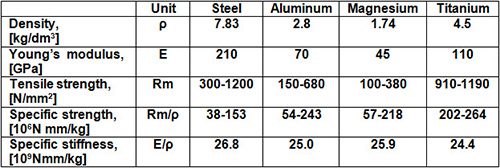Deep Drawing of Aluminum Alloys: Part One
Abstract
Driven by the notoriously high demands of the automotive industry the quest to find more efficient, cheaper and better quality methods to produce materials is ever present.
Deep drawing, the process of turning sheet metal into hollow parts, is a critical production process and from the measurement of certain material properties it can be seen that aluminum has favorable performance when compared to steels.
Sheet metal forming technologies have been constantly challenged by improvements in the automotive industry over the last several decades. Due to increasing customer expectations, safety requirements and market competition, there is a strong need for products, which can be manufactured more successfully, more economically and swiftly to satisfy these ever-increasing market needs. The outcome of sheet metal forming processes, and especially deep drawing processes are strongly dependent on the materials used.
Deep drawing is the most important process of shaping sheet, where largely deformed metal sheets are turned into the hollow parts. Experimentally, several laboratory methods are utilized to assess the ductility of the sheets. These test methods include cylindrical cup deep drawing and deep shaping operations. In deep drawing sheet metal is draw into a hollow cylindrical shape where the applied forces often are symmetrical. The mechanical properties of the sheet are not often the same in all directions and the crystal anisotropy of sheet materials can be the cause of heterogeneity in the direction of the grain crystallization. Deep-drawn products further require operating margins, which would increase production costs and making thinner products would be helpful to the overall costs. The deep-drawing industry produces metal containers such as pressure or vacuum tanks, some cars and aircraft spare parts, shell and bullet cans and cans for the soft drinks industry.
Some material properties of common metals are given in the Table 1.

Table 1: Material properties of common metallic materials
It can be seen from Table 1 that average steels have high stiffness and strength with a large density, whereas aluminum has moderate- but subjectively good values, making them more popular for deep drawing applications. On the other hand the smaller density and corrosion resistance of aluminum makes it a good candidate for a replacement material for steel.
The design and control of a deep drawing process depends not only on the material, but also on the condition of the tool material interface, the mechanics of plastic deformation, the equipment used, and the control of metal flow. The equipment and tooling parameters that affect the success or failure of a deep drawing operation are the punch, die radii, die clearance, the press speed, the lubrication, the type of restraint to metal flow such as blank holding force (BHF), blank holder gap (BHG), and draw bead. All of these three types of restraints create restraining force by friction between the strip and the tooling.
The use of aluminum (Al) alloys in automotive applications has doubled, mostly due to their high strength to weight ratio and excellent recyclability, which subsequently translate to considerable cost saving. However, since the costs of the Al alloys are higher than those of steels. Further decrease in cost is important so as to expand the usage of these alloys.
To establish the geometry of a part, it is essential to know the limit to which the part material can be formed without reaching failure. This forming limit depends, in addition to the shape change and process conditions, on the ability of a material to deform without failure. The limit drawing ratio (LDR) is commonly used to provide a measure of the drawability of sheet metal.
In the work of Gavaz M., the effect of multi-point blank holder on the LDR of Al-1050 sheets was investigated using (BHG) defined as the fixed distance between the blank holder and the die surface in the stamping process by Weili et al. to promote the deep drawability of aluminum sheets.
A higher LDR and cup height are achieved compared to a normal blank holder when the multi-point blank holder is used. Surface quality is nearly the same compared to normal blank holding systems, however, slight ball-scratch was found on the inner surface of the side wall of the cup. In this method, though the drawing height and LDR are increased, it is not very practical because of placing difficulties of the balls under the blank holder with grease.
This method can be used practically placing the balls to the blank holder tightly with another method that will be investigated, or making the blank holder surface multi-point with different methods without placing the balls. Using a multi-point blank holder may not be the best method to obtain the highest LDR, but it can increase the LDR substantially and can be used for special purposes successfully.
Access Precise Properties of Aluminum Alloys Now!
Total Materia Horizon contains property information for 30,000+ alumiums: composition, mechanical, physical and electrical properties, nonlinear properties and much more.

Get a FREE test account at Total Materia Horizon and join a community of over 500,000 users from more than 120 countries.